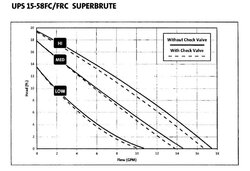This seems to be easy, but I must be tired. I have a flowmeter with a 2 psi pressure drop (4.6 ft head). If I have 8 gpm (1" pipe) with the flowmeter (about 11 feet of head), and now I remove the flowmeter (head decreases by 4.6 feet), what is the approximate flow? Circ is Grundfos UPS 15-58FRC operating on HI.
Pump Head - Flow Calculation
- Thread starter jebatty
- Start date
-
Active since 1995, Hearth.com is THE place on the internet for free information and advice about wood stoves, pellet stoves and other energy saving equipment.
We strive to provide opinions, articles, discussions and history related to Hearth Products and in a more general sense, energy issues.
We promote the EFFICIENT, RESPONSIBLE, CLEAN and SAFE use of all fuels, whether renewable or fossil.


